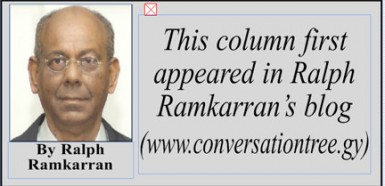
The Indian population has declined from 326,277 or 43.4% in 2002 to 297,493 or 39.8% in 2012. The African population has declined from 227,062 or 30.2% in 2002 to 218,483 or 29.2% in 2012. The Amerindian population increased from 66,675 or 9.1% in 2002 to 78,492 or 10.5% in 2012. The Mixed population increased from 125,727 or 16.7% in 2002 to 148,532 or 19.9% in 2012.
In an article on July 12, 2014 (‘The census and its political implications’), I had suggested that the Indian population figure had gone below 40% and that could have been one factor that negatively impacted on support for the PPP at the 2011 elections. Other reasons were that the population of Region 6, a stronghold of the PPP had declined by 15,000, some former support of the PPP moving to the AFC and some voter apathy among PPP supporters.
The PPP obtains its support from the Indian and Amerindian communities. The Indian population declined by 96,924 between 1980 and 2012, that is, from 394,417 to 297,493, an absolute decline of 24%. The increase in size of the Amerindian population did not make up for the decline in the Indian population. Amerindians increased by 38,149 between 1980 and 2012, that is, from 40,343 in 1980 to 78,492 in 2012. The difference between the reduction of Indians and the increase of Amerindians shows a net loss of 58,775 or 15% among the PPP’s voting support.
The APNU obtains most of its support from the African and Mixed communities. Between 2002 and 2012 the African population declined by 1% and the Mixed population increased by 3.2%. The APNU has therefore benefited from a net increase of 2.2% in the population on which it relies for most of its support. In numbers the African population lost 8,579 persons while the Mixed population increased by 22,805, a net increase of 14,226 or 7%.
Neither the numerical nor the percentage support obtained by the parties between 1992 and 2011 show any basis on which it can be concluded that the ethnic population figures have had an impact on the results. The PPP’s support went up from 166,340 in 2011 to 202,694 in 2015, reflecting an intensification of political work after its disastrous performance in 2011. APNU may also have increased from 139,678 in 2011 due to a similar intensification, but there is no way to tell what was the portion of the total vote of 207,200 that APNU attracted, since some of those votes were brought in by the AFC.
The PPP appears to be confident that in a straight contest between the PPP and APNU in 2020, it can recover an absolute majority because of diminishing support for the AFC.
However, its own support among the Indian business and professional classes and the larger Indian middle class is weakening and its leadership is either jaded or short of talent and the capacity to inspire. It also carries much baggage from its 23-year rule. APNU, on the other hand, has the advantage of an increasing Mixed population and the perquisites of government to entice Amerindian support away from the PPP. Its cleaner record in this era of its governance will be positive in an appeal to be a manager of greater integrity than the PPP of our oil income.
The Indian population is declining more rapidly than any other. It declined 3% between 1980 and 1991, 5% between 1991 and 2002 and 4% between 2002 and 2012. The African population increased by 2% between 1980 and 1991, declined by 2% between 1991 and 2002 and declined by 1% between 2001 to 2012. The increased size of the Mixed population benefits APNU far more than the PPP. It is this vote that carried APNU and the PNC and PNCR in the past to as much as between 40% and 43%, even though the African population is only 30% of the population. The Amerindian support similarly carries the PPP above the 39%-43% Indian population.
The speed of the decline of the Indian population suggests that the PPP cannot expect to sustain electoral and political dominance, even if it does so in the short term. For APNU, the declining support of the AFC places the coalition in danger of losing a straight electoral battle with the PPP. But our political history suggests that, with an ingrained culture of ethno/political competition, APNU+AFC and the PPP will take their chances in the next elections.
While political differences and disputes are no worse in Guyana than elsewhere, the fact that one half of the population feels alienated when it perceives that the other half is in power, hinders investment and economic progress. But the drive for ethno/political supremacy is so compelling that new constitutional approaches which might alter the system of election of the President and the structure of the state to encourage compromise and inclusivity in our political process, is hardly on the front burner. The intent and bona fides of the two main political parties will be tested in the upcoming constitutional reform process.




